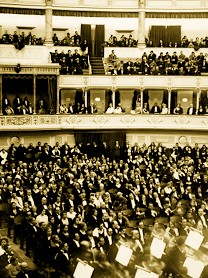 The Accademia soon became aware of the inadequacy of the space in the Sala Accademica, especially for the symphonic repertoire. Thus it began to search for an appropriate place to construct an auditorium worthy of the capital city. It even considered the interior of the Galleria Colonna on Via del Corso, but in the end it focused its attention on the Corea Amphitheater above the ancient Mausoleum of Augustus which had, over the centuries, housed noble families and hosted spectacles for the masses such as bullfights and fireworks.
The Accademia soon became aware of the inadequacy of the space in the Sala Accademica, especially for the symphonic repertoire. Thus it began to search for an appropriate place to construct an auditorium worthy of the capital city. It even considered the interior of the Galleria Colonna on Via del Corso, but in the end it focused its attention on the Corea Amphitheater above the ancient Mausoleum of Augustus which had, over the centuries, housed noble families and hosted spectacles for the masses such as bullfights and fireworks.
On 16 February 1908, the new concert hall – with a seating capacity of more than 3,000 – was inaugurated with a concert conducted by Giuseppe Martucci; it soon took the name the Augusteo. Until 13 May 1936, the date of the last concert before the hall was demolished on the orders of the fascist regime, the Augusteo was the home of the Accademia symphonic seasons, while the chamber season continued to take place in the Sala Accademica. All the major soloists and conductors of the era, from Mengelberg and Fürtwängler to Toscanini, Bruno Walter and Claude Debussy, ascended the podium of the Augusteo, which was dominated by Bernardino Molinari, then permanent artistic conductor of the Santa Cecilia Orchestra. Beginning in June 1933, the Accademia added a summer season to its traditional symphonic and chamber seasons, which took place at the Basilica di Massenzio in the Roman Forum. By May 1936, the Accademia had presented a total of 1,836 concerts since its establishment.
| il tuo nome: | |
| la tua email: | |
| il suo nome: | |
| la sua email: |
per invio multiplo di email separare con la virgola
messaggio inviato con successo all'indirizzo
si è verificato un errore nell'invio della mail all'indirizzo